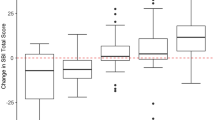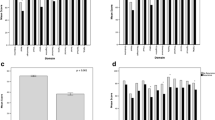Abstract
Introduction
The extirpation of skull base malignancies may be associated with significant morbidity and can profoundly impact health related quality of life (HRQOL). In this review, we sought to provide an overview of HRQOL and the factors that influence it for patients with skull base malignancies.
Materials and Methods
Narrative review.
Results
HRQOL tends to improve in the months to years following treatment and is profoundly impacted by both tumor location and treatment approach. Wherever possible, HRQOL should always be elicited from the patient directly. Several HRQOL instruments have been used in this population including generic, site-specific and disease specific measures.
Conclusion
Given that HRQOL is a multidimensional concept with several important facets, validated disease-specific instruments are generally preferred.




Similar content being viewed by others
References
Ganly I, Patel SG, Singh B et al (2005) Complications of craniofacial resection for malignant tumors of the skull base: report of an International Collaborative Study. Head Neck 27(6):445–451
Gil Z, Abergel A, Spektor S et al (2003) Quality of life following surgery for anterior skull base tumors. Arch Otolaryngol 129(12):1303–1309
Abu-Kishk I, Klin B, Gilady-Doron N, Jeroukhimov I, Eshel G (2013) Hospitalization due to horse-related injuries: has anything changed? A 25 year survey. Israel Med Assoc J 15(4):169–172
Gil Z, Fliss D (2010) Quality of life in patients with skull base tumors: current status and future challenges. Skull Base 20(01):011–018
Glicksman JT, Parasher AK, Brooks SG et al (2018) Sinonasal quality of life after endoscopic resection of malignant sinonasal and skull base tumors. Laryngoscope 128(4):789–793
Derousseau T, Manjunath L, Harrow B, Zhang S, Batra PS. Long‐term changes in quality of life after endoscopic resection of sinonasal and skull‐base tumors. Paper presented at: International forum of allergy & rhinology2015.
Shah JP (2010) Quality of life after skull base surgery: the patient's predicament. Skull Base 20(01):003–004
Kirkman MA, Borg A, Al-Mousa A, Haliasos N, Choi D (2014) Quality-of-life after anterior skull base surgery: a systematic review. J Neurol Surg B 75(02):073–089
Schaberg MR (2018) Quality of life outcomes after endoscopic approaches to intracranial tumors. Curr Opin Otolaryngol Head Neck Surg 26(1):58–64
Group W (1995) The World Health Organization quality of life assessment (WHOQOL): position paper from the World Health Organization. Soc Sci Med 41(10):1403–1409
Guyatt GH, Feeny DH, Patrick DL (1993) Measuring health-related quality of life. Ann Intern Med 118(8):622–629
Velikova G, Booth L, Smith AB et al (2004) Measuring quality of life in routine oncology practice improves communication and patient well-being: a randomized controlled trial. J Clin Oncol 22(4):714–724
Myers EN, Hammerlid E, Persson L-O, Sullivan M, Westin T (1999) Quality-of-life effects of psychosocial intervention in patients with head and neck cancer. Otolaryngology 120(4):507–516
Ringash J, Bezjak A (2001) A structured review of quality of life instruments for head and neck cancer patients. Head Neck 23(3):201–213
Gil Z, Abergel A, Spektor S, Khafif A, Fliss DM (2004) Patient, caregiver, and surgeon perceptions of quality of life following anterior skull base surgery. Arch Otolaryngol 130(11):1276–1281
Karnofsky DA (1949) The clinical evaluation of chemotherapeutic agents in cancer. Eval Chemother Agents 9:191–205
Holmes B, Sekhar L, Sofaer S, Holmes K, Wright D (1995) Outcomes analysis in cranial base surgery—preliminary results. Acta Neurochir 134(3–4):136–138
Walch C, Stammberger H, Anderhuber W, Unger F, Köle W, Feichtinger K (2000) The minimally invasive approach to olfactory neuroblastoma: combined endoscopic and stereotactic treatment. Laryngoscope 110(4):635–640
Raso JL, Gusmão S (2006) Transbasal approach to skull base tumors: evaluation and proposal of classification. Surg Neurol 65:S33–S37
Tzortzidis F, Elahi F, Wright D, Natarajan SK, Sekhar LN (2006) Patient outcome at long-term follow-up after aggressive microsurgical resection of cranial base chordomas. Neurosurgery 59(2):230–237
Di Maio S, Rostomily R, Sekhar LN (2011) Current surgical outcomes for cranial base chordomas: cohort study of 95 patients. Neurosurgery 70(6):1355–1360
Samii A, Gerganov V, Herold C, Gharabaghi A, Hayashi N, Samii M (2009) Surgical treatment of skull base chondrosarcomas. Neurosurg Rev 32(1):67
Lang D, Honeybul S, Neil-Dwyer G, Evans B, Weller R, Gill J (1999) The extended transbasal approach: clinical applications and complications. Acta Neurochir 141(6):579–585
Ware JE Jr, Sherbourne CD (1992) The MOS 36-item short-form health survey (SF-36): I: Conceptual framework and item selection. Med Care 30:473–483
Ransom ER, Doghramji L, Palmer JN, Chiu AG (2012) Global and disease-specific health-related quality of life after complete endoscopic resection of anterior skull base neoplasms. Am J Rhinol Allerg 26(1):76–79
Ware JE Jr, Kosinski M, Keller SD (1996) A 12-item short-form health survey: construction of scales and preliminary tests of reliability and validity. Med Care 34:220–233
Torrance GW, Feeny DH, Furlong WJ, Barr RD, Zhang Y, Wang Q (1996) Multiattribute utility function for a comprehensive health status classification system: Health Utilities Index Mark 2. Med Care 34(7):702–722
Hassan SJ, Weymuller EA (1993) Assessment of quality of life in head and neck cancer patients. Head Neck 15(6):485–496
Rogers SN, Gwanne S, Lowe D, Humphris G, Yueh B, Weymuller EA Jr (2002) The addition of mood and anxiety domains to the University of Washington quality of life scale. Head Neck 24(6):521–529
Martinez-Devesa P, Barnes M, Alcock C, Kerr R, Milford C (2006) Evaluation of quality of life and psychiatric morbidity in patients with malignant tumours of the skull base. J Laryngol Otol 120(12):1049–1054
Palme CE, Irish JC, Gullane PJ, Katz MR, Devins GM, Bachar G (2009) Quality of life analysis in patients with anterior skull base neoplasms. Head Neck 31(10):1326–1334
List MA, D'Antonio LL, Cella DF et al (1996) The performance status scale for head and neck cancer patients and the functional assessment of cancer therapy‐head and neck scale: a study of utility and validity. Cancer 77(11):2294–2301
Hopkins C, Gillett S, Slack R, Lund V, Browne J (2009) Psychometric validity of the 22-item Sinonasal Outcome Test. Clin Otolaryngol 34(5):447–454
Gil Z, Abergel A, Spektor S, Shabtai E, Khafif A, Fliss DM (2004) Development of a cancer-specific anterior skull base quality-of-life questionnaire. J Neurosurg 100(5):813–819
Little AS, Jahnke H, Nakaji P, Milligan J, Chapple K, White WL (2012) The anterior skull base nasal inventory (ASK nasal inventory): a clinical tool for evaluating rhinological outcomes after endonasal surgery for pituitary and cranial base lesions. Pituitary 15(4):513–517
Little AS, Kelly D, Milligan J et al (2013) Prospective validation of a patient-reported nasal quality-of-life tool for endonasal skull base surgery: the Anterior Skull Base Nasal Inventory-12. J Neurosurg 119(4):1068–1074
ten Dam E, Feijen RA, van den Berge MJ et al (2017) Development of the endoscopic endonasal sinus and skull base surgery questionnaire. Paper presented at: International forum of allergy & rhinology
de Almeida JR, Vescan AD, Gullane PJ et al (2012) Development of a disease-specific quality-of-life questionnaire for anterior and central skull base pathology—the skull base inventory. Laryngoscope 122(9):1933–1942
Abergel A, Cavel O, Margalit N, Fliss DM, Gil Z (2012) Comparison of quality of life after transnasal endoscopic vs open skull base tumor resection. Arch Otolaryngol 138(2):142–147
Fliss DM, Abergel A, Cavel O, Margalit N, Gil Z (2007) Combined subcranial approaches for excision of complex anterior skull base tumors. Arch Otolaryngol 133(9):888–896
ten Dam E, Korsten-Meijer AG, Hoving EW et al (2019) Evaluation of the psychometric properties of the endoscopic endonasal sinus and skull base surgery questionnaire (EES-Q) in a prospective cohort study. Clin Otolaryngol 44:565–571
Larjani S, Monteiro E, Witterick I et al (2016) Preliminary cross-sectional reliability and validity of the Skull Base Inventory (SBI) quality of life questionnaire. J Otolaryngol 45(1):45
de Almeida JR, Vescan AD, Witterick IJ et al (2015) Changes experienced in quality of life for skull base surgical patients: a qualitative case study. J Neurol Surg B 76(02):129–144
de Almeida JR, Witterick IJ, Vescan AD (2011) Functional outcomes for endoscopic and open skull base surgery: an evidence-based review. Otolaryngol Clin North Am 44(5):1185–1200
de Almeida JR, Snyderman CH, Gardner PA, Carrau RL, Vescan AD (2011) Nasal morbidity following endoscopic skull base surgery: a prospective cohort study. Head Neck 33(4):547–551
Woertgen C, Rothoerl RD, Hosemann W, Strutz J (2007) Quality of life following surgery for malignancies of the anterior skull base. Skull Base 17(02):119–123
de Almeida JR, Witterick IJ, Gullane PJ et al (2013) Physical morbidity by surgical approach and tumor location in skull base surgery. Head Neck 35(4):493–499
Hadad G, Bassagasteguy L, Carrau RL et al (2006) A novel reconstructive technique after endoscopic expanded endonasal approaches: vascular pedicle nasoseptal flap. Laryngoscope 116(10):1882–1886
Meccariello G, Deganello A, Choussy O et al (2016) Endoscopic nasal versus open approach for the management of sinonasal adenocarcinoma: a pooled-analysis of 1826 patients. Head Neck 38(S1):E2267–E2274
Rawal RB, Farzal Z, Federspiel JJ, Sreenath SB, Thorp BD, Zanation AM (2016) Endoscopic resection of sinonasal malignancy: a systematic review and meta-analysis. Otolaryngology 155(3):376–386
Farquhar D, Kim L, Worrall D et al (2016) Propensity score analysis of endoscopic and open approaches to malignant paranasal and anterior skull base tumor outcomes. Laryngoscope 126(8):1724–1729
Husain Q, Joshi RR, Cracchiolo JR et al (2019) Surgical management patterns of sinonasal malignancy: a population-based study. J Neurol Surg B 80(04):371–379
Carrabba G, Dehdashti AR, Gentili F (2008) Surgery for clival lesions: open resection versus the expanded endoscopic endonasal approach. Neurosurg Focus 25(6):E7
Fatemi N, Dusick JR, Gorgulho AA et al (2008) Endonasal microscopic removal of clival chordomas. Surg Neurol 69(4):331–338
Pant H, Bhatki AM, Snyderman CH et al (2010) Quality of life following endonasal skull base surgery. Skull Base 20(01):035–040
McCoul E, Anand K, Schwartz T (2012) Improvements in site-specific quality of life 6 months after endoscopic anterior skull base surgery: a prospective study—clinical article. J Neurosurg 117:498–506
Castelnuovo P, Pagella F, Delù G, Benazzo M, Cerniglia M (2003) Endoscopic resection of nasal haemangiopericytoma. Eur Arch Otorhinolaryngol 260(5):244–247
Abergel A, Fliss DM, Margalit N, Gil Z (2010) A prospective evaluation of short-term health-related quality of life in patients undergoing anterior skull base surgery. Skull Base 20(01):027–033
Fukuda K, Saeki N, Mine S et al (2000) Evaluation of outcome and QOL in patients with craniofacial resection for malignant tumors involving the anterior skull base. Neurol Res 22(6):545–550
Weitzner MA, Meyers CA, Gelke CK, Byrne KS, Levin VA, Cella DF (1995) The functional assessment of cancer therapy (FACT) scale: development of a brain subscale and revalidation of the general version (FACT-G) in patients with primary brain tumors. Cancer 75(5):1151–1161
Meyers CA, Hess KR (2003) Multifaceted end points in brain tumor clinical trials: cognitive deterioration precedes MRI progression. Neuro Oncol 5(2):89–95
Meyers CA, Geara F, Wong P-F, Morrison WH (2000) Neurocognitive effects of therapeutic irradiation for base of skull tumors. Int J Rad Oncol Biol Phys 46(1):51–55
Deschler DG, Walsh KA, Friedman S, Hayden RE (1999) Quality of life assessment in patients undergoing head and neck surgery as evaluated by lay caregivers. Laryngoscope 109(1):42–46
Funding
No funding sources to disclose.
Author information
Authors and Affiliations
Corresponding author
Ethics declarations
Conflict of interest
All authors declare that they have no competing interest.
Ethical approval
This article does not contain any studies with human participants or animals performed by any of the authors.
Additional information
Publisher's Note
Springer Nature remains neutral with regard to jurisdictional claims in published maps and institutional affiliations.
Rights and permissions
About this article
Cite this article
Noel, C.W., de Almeida, J.R. Quality of life considerations for patients with anterior and central skull base malignancies. J Neurooncol 150, 501–508 (2020). https://doi.org/10.1007/s11060-019-03367-w
Received:
Accepted:
Published:
Issue Date:
DOI: https://doi.org/10.1007/s11060-019-03367-w




